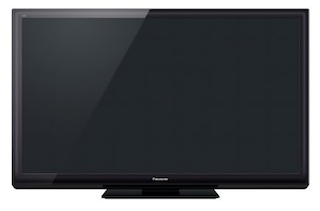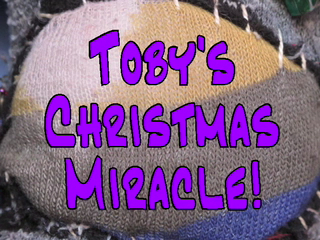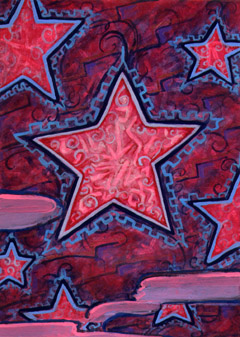December 2011 archives
you are here [x]: Scarlet Star Studios > the Scarlet Letters > December 2011
<< before
October 2011
after >>
January 2012
December 27, 2011
the great leap forward: from analog to hdtv
by sven at 5:10 pm

If you check the electronics section of your local department store, it's clear that society has transitioned from Cathode Ray Tube (CRT) televisions to High Definition flat screens. I have pretty mixed feelings about this. But now that I'm running the NW Animation Festival, I finally have compelling reasons to catch up with the times. Both for better and for worse.
THE GOOD
Here's what excites me. After maybe a decade and a half of slow development and format wars, HD standards have finally solidified. Every filmmaker should be producing work with Blu-ray resolution in mind: 16:9 aspect ratio, 1920x1080 pixels, 24 frames per second, progressive. I reel reasonably confident that this standard will hold for the next ten years.
I'm thrilled that the standards for television and cinema have begun to converge. A 16:9 aspect ratio is nearly identical to the most common one for screens in movie theaters: 1.85:1. Regrettably, digital broadcast television remains based on the old 30fps NTSC standard; however, Blu-ray and most HDTVs now have native support for 24fps—the same frame rate used for celluloid. Coming from the other direction, big chain movie theaters are rapidly transitioning from celluloid to digital projection. One well-regarded industry report forecasts that by 2015, 35mm film will be projected on only 17% of screens, globally.
As a filmmaker, I crave to make films that screen equally well on a home TV or in a movie theatre. Good riddance to 4:3 aspect ratios, 30fps, and interlacing!
THE BAD
Now here's the bad news. Despite the hype, Hi Def televisions are still an adolescent technology. And it really shows. Analog televisions have been in our homes since roughly the 1930s. They are dependable, predictable, and fairly forgiving. HDTVs look vastly superior when you play a well-authored Blu-ray disc—but can make anything less look damnably awful.
A poor broadcast signal will lead to huge blocks of stuttering pixels. A poorly compressed film of any sort has artifacts that look like mosquitos. Movies that were shot on film, often lose their cinematic quality when displayed on an HDTV, instead having that "too crisp" look of video. Digital media are much less forgiving of audio clipping, which becomes a harsh buzz. While Blu-ray players are backwards-compatible for playing DVDs, most of my (considerable) collection now looks muddy and pixelated unless I sit far back from the screen.
As I said, the technology is in its adolescence. Given another 5-10 years, it ought to be easy enough to compensate for these awkward translations of data. I'm not sure that the industry is interested in improving quality, though. By making anything less than Hi Def data nearly unwatchable, society is forced to abandon DVDs and the like, and adopt the best new formats. It just seems a bit mean-spirited when the majority of digital content currently looks like crap.
"Upgrading" to HDTV, I feel like we've now caught up with where society is going... But with the understanding that we haven't really evolved to a higher level of being—rather, we're all going to go through some rocky technological times together.
OUR CHOICE
At least I feel confident that we made the best selection possible at this point in time. We went for a Panasonic VIERA TC-P42ST30 42-Inch 1080p 3D Plasma HDTV.
There are three major flat screen technologies at present: plasma, LCD, and LED. Of them, plasma has been around the longest and is best developed. One indicator of this is refresh rate. A typical plasma refresh rate is 600Hz, whereas many LCDs are still only 60Hz. LED is the newest hybrid technology, which has the best brightness—but gives uneven luminance because the LEDs are only positioned around the edges of the picture frame.
Among producers of plasma TVs, Panasonic is currently the industry leader. Plasma TVs are noticeably dimmer than LCDs, but also have the ability to show blacker blacks. Plasmas are viewable from a wider range of angles than LCDs. There's a danger with Plasma that images will burn a permanent afterimage into the screen if you leave them on too long. However, we don't really play video games or watch TV channels with logos in the corners, and "neo plasma" technologies have lessened the problem—so this wasn't a big concern.
Ultimately, what I'm most looking forward to is running film jurying sessions for the NW Animation Festival, where I can run a single cable from my laptop to the TV and show films at full resolution. (And without having to be concerned about TV-safe areas!) I'm also excited to see the 1920x1080 version of my film Mutate displayed at full resolution for the first time.
It's curious... Technology has moved "forward"—in the process making the majority of available content look much worse. It cools my desire to be a media consumer—but simultaneously fuels my interest in creating new content that will look excellent using the new tools at hand.
posted by sven | permalink | categories: nw animation festival, studio space
December 24, 2011
toby's christmas miracle!
by sven at 7:00 am

A Scarlet Star Studios Christmas tradition…
It's a comedy.
It's animated.
It's a MUSICAL.
Watch!
(Also available on YouTube.)
posted by sven | permalink | categories: toby
December 21, 2011
merry solstice from scarlet star studios!
by sven at 11:40 am

Tonight is the longest night of the year. As the world gently tips, beginning our journey back toward light, we send you our best and brightest wishes…
From Sven & Gretchin: merry solstice!